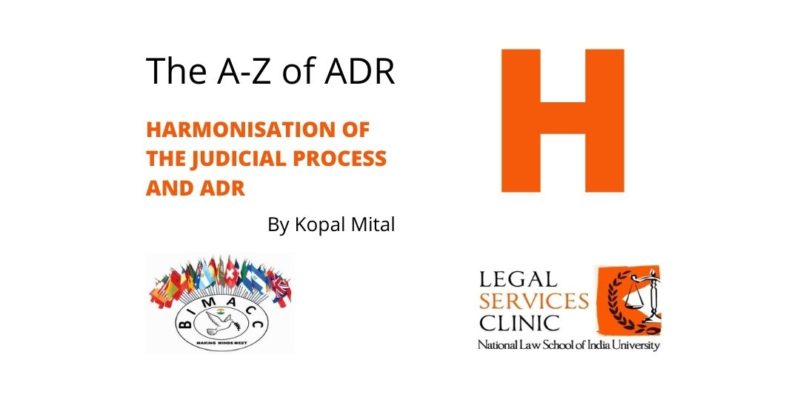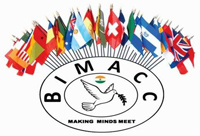
A-Z of ADR: Harmonisation of the Judicial Process and ADR
-Kopal Mital (II Year, NLSIU Bangalore)
Introduction
Mechanisms of Alternative Dispute Resolution have gained a lot of importance recently. The advantages of ADR are numerous. One of the most significant advantages of ADR is that it allows the parties to reach a settlement that meets both their interests.
This article explores the incorporation of the ADR mechanism in the working of the judiciary. It analyses Section 89 of the Civil Procedure Code. It then takes a look at how ADR has been incorporated into various other legislations. Finally, the article explores certain characteristics of the Lok Adalats in India.
Section 89 of the Civil Procedure Code
Given the immense burden and backlogs faced by the legal system, ADR provides some welcome respite to manage some of this load. It offers speedy solutions and the parties to the dispute drive the process. One of the most significant moves that aimed to harmonise the legal systems and ADR mechanisms is Section 89 of the Code of Civil Procedure. Section 89 provides that if there exists any scope for settlement among the parties, the matter must be referred to any one of these ADR mechanisms namely, arbitration, conciliation, judicial settlement including settlement through Lok Adalat or mediation.[1] However, this Section has presented certain difficulties. The wording of the Section indicates that the judge referring the dispute to one of these mechanisms must formulate the terms of settlement for the parties. It gives the impression that the Court must engage in an in-depth analysis of the situation and then frame the terms of settlement. In such a case, the entire purpose of dispute resolution will become redundant. This is because it is the parties who must decide what they want to discuss. The parties must reach these terms of settlement through the course of their interactions with each other. If the courts engage in this exercise, it discards the need for ADR. However, the correct interpretation was laid down by the Supreme Court in Afcons Infrastructure Ltd. Vs. Cherian Varkey Construction Co. (P) Ltd.[2] The Court held that:
“Therefore, the only practical way of reading Section 89 and Order 10 Rule 1-A is that after the pleadings are complete and after seeking admissions/denials wherever required, and before framing issues, the Court will have recourse to Section 89 of the Code. Such recourse requires the court to consider and record the nature of the dispute, inform the parties about five options available and take note of their preferences and then refer them to one of the alternative dispute resolution processes.”
This has settled the question of interpretation of Section 89.
ADR and Other Legislations
Apart from this, a reference to ADR mechanisms can be found in a variety of other legislations. The preamble of the Family Court Act, 1984, clearly states that the purpose of setting up the Act is to promote conciliation in family disputes and ensure speedy disposal of cases.[3] Section 10-A of the Industrial Disputes Act,1947 provides for voluntary reference of disputes to arbitration.[4] The Act also provides for conciliation. It clearly lays out the duties of the conciliator. The Maintenance and Welfare of Parents and Senior Citizens Act, 2007 provides for Conciliation. It states that in case it is felt by the Tribunal that the dispute can be settled amicably, it is referred to a Conciliator. Both of these Acts give the impression that ADR would be ideal for solving familial disputes. Family disputes are sensitive in nature. Parties in these disputes need to communicate with one another. Conciliation helps facilitate such communication. The Commercial Courts Act was amended in 2018 makes it compulsory for parties to first go through mediation and only then approach the courts.[5] All of the provisions attempt to incorporate various ADR mechanism for the speedy redressal of grievances.
Lok Adalat
Lok Adalat is a unique mechanism designed to address the social challenges which arise in India. The Lok Adalat or People’s Court was started with the intention of making justice accessible to all. The Committee for Implementing Legal Aid Schemes headed by Justice P.N Bhagwati set out to raise legal awareness among people with special focus on rural areas.[6]
The Lok Adalat provides a forum where cases can be settled amicably either if they are pending or if they are at a pre-litigation stage.[7] The Lok Adalat does not adjudicate the dispute on the basis of its legal merits. The cases are decided by statutory conciliators. They do not decide these cases in a judicial capacity. They facilitate the process so that parties can reach a settlement which is agreeable to them. There no need for court fees to be paid. If it has been paid, it is refunded if the case settled by the Lok Adalat. The decision of the Lok Adalat is binding like a civil decree.[8] The formalistic nature of the judicial system creates certain barriers which make it difficult for a lot of people to approach the courts. Lok Adalats are an affordable method of settling disputes. It provides speedy justice. By making the process an interaction between the parties, it gives them a chance to play an active role in resolving their own dispute.
Conclusion
While all of these mechanisms have been incorporated, there is still a long way to go in making ADR a go-to option. This where it becomes pertinent for lawyers and judges to take charge. As stated by Justice DY Chandrachud, there needs to be a “fundamental change in the mindset” towards dispute resolution. We need to change the image of only courts rendering justice. Incorporation of ADR into the judicial system can help containment of disputes. This will ensure that disputes that can be solved through consensus need not reach the courts.[9] In the post-pandemic period, the Courts will be confronted with an increased number of cases. This presents an opportunity to utilise the ADR mechanisms to their maximum limit.
[1] Sec. 89, Code of Civil Procedure, 1908.
[2] (2010) 8 SCC 24
[3] Preamble, Family Court Act, 1984.
[4] Sec. 10-A, Industrial Disputes Act,1947.
[5] Chapter III-A, The Commercial Courts, Commercial Division and Commercial Appellate Division of High Courts (Amendment) Act, 2018 < http://egazette.nic.in/WriteReadData/2018/188688.pdf> accessed 27 July 2020.
[6] Department of Justice, ‘An Analysis of the functioning of Lok Adalats in the Eastern Region of India: A Comparative Report’, < https://doj.gov.in/sites/default/files/OJA.pdf> accessed 26 July 2020.
[7] National Legal Services Authority, ‘Lok Adalat’, < https://nalsa.gov.in/lok-adalat> accessed 27 July 2020.
[8] Department of Justice n 6.
[9] NITI Aayog, ‘Catalyzing Online Dispute Resolution in India’ (12 June 2020), <https://niti.gov.in/catalyzing-online-dispute-resolution-india> accessed on 28 July 2020.
-Kopal Mital (II Year, NLSIU Bangalore)
Kopal Mital is a second-year student from the National Law School of India University (NLSIU), Bangalore.
BIMACC expresses its gratitude towards the author and to the members of the Legal Services Clinic, National Law School of India University (NLSIU) for their support in our collaborative efforts to promote ADR with this series titled “A-Z of ADR”. The purpose of this series is to increase the understanding of certain fundamental concepts of Alternative Dispute Resolution.
The Legal Services Clinic is a student-run committee that provides free legal services to the socially and the economically backward sections of the society who have difficulty accessing the judicial system. It also has a mandate of spreading legal awareness and providing free legal assistance to those who cannot afford it.
Website: www.legalservicesclinic.org/
Facebook: @legalservicesclinic
Email: lsc.nlsiu@gmail.com
Phone Number: 073586 73214
Disclaimer: The views and opinions expressed in this blog are those of the author and do not necessarily reflect the official policy or position of BIMACC, any of the members of the Board, or the empanelled neutrals. This blog is for informative purpose only and does not constitute legal advice in any manner whatsoever.
